Bansberia (Hooghly- 48 km. from kolkata)
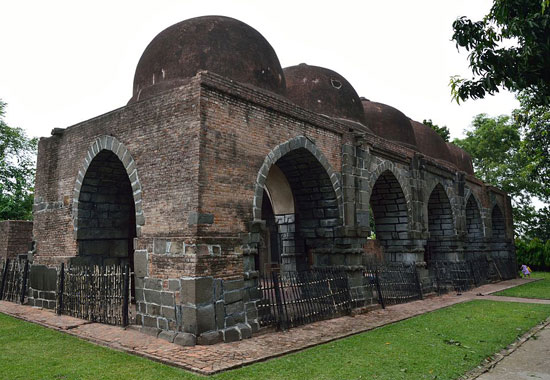
Bansberia is a town and a municipality in Hooghly district in the state of West Bengal, India. It is under Mogra/ Chinsurah police stations in Chinsurah subdivision. It is at the western end of the Kalyani Bridge, and a part of the area covered by Kolkata Metropolitan Development Authority. Bansberia is 4 km from Bandel on the Bandel-Katwa branch line.
Present Bansberia was one of the main villages of ancient Saptagram and was once the commercial complex and main port of that area. The existence of the place dates back to the period of Shah Jahan. An area including Bansberia was part of the Mughal Empire and the Zamindar was Raghab Dattaroy of Patuli. The place derived its name from the legend that a fort was built by Raghab's son after clearing a bamboo grove.
Bansberia was one of the main villages of ancient Saptagram, once the main port and commercial complex in the area. The temples of Ananta Vasudeva and Hangseshwari are famous here. The Vasudeva temple is constructed in the traditional ekaratna style with curved cornices and an octagonal tower. Hangseshwari temple has a unique architectural style. There are thirteen minars, each shaped like a lotus bud, and the inner layout follows the human anatomy.
Zafar Khan Ghazi Mosque and Dargah situated at Tribeni in Hughli district, West Bengal, India, are considered to be among the earliest surviving Muslim monuments in Bengal. According to an inscription, the mosque is dated 698 AH (1298 AD). Tribeni (junction of three rivers viz, the Ganges, the Yamuna, and the Sarasvati - hence the name) was an ancient holy place of the Hindus. The Muslims conquered it during the early phase of their conquest of Bengal. The mosque is an oblong structure measuring 23.38 by 10.53 metres (76.7 by 34.5 ft) externally. It is the earliest surviving example of the brick-and-stone style introduced by the Muslims in Bengal in place of the traditional Hindu style of laying rectangular cut stones one upon another without mortar. The stones used in the mosque were originally materials from temples, as evidenced by figures of Hindu deities carved on some pieces.
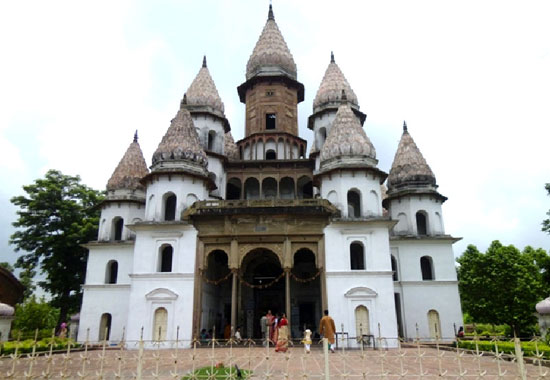
Nearby attractions: You can wander along the Hooghly to Ishwar Gupta Bridge, Hangseshwari temple, Ananta Basudeba Temple or visit Bandel that is situated at a distance of four kilometers and offers a number of tourist attractions.
Best visit time: Any time of the year but rainy season is not preferable.
Chandannagar (Hooghly- 44 km. from kolkata)
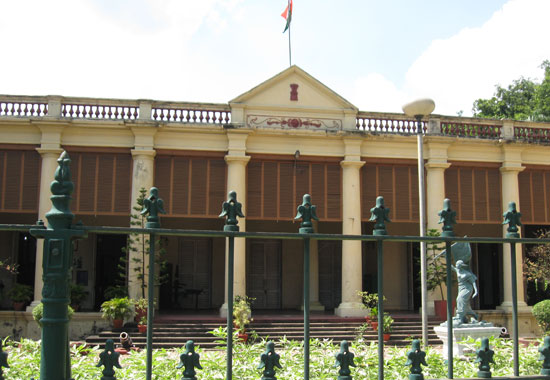
Chandannagar, formerly spelled as Chandernagore is a Corporation city and former French colony located 35 kilometers (22 mi) north of Kolkata, in West Bengal, India. It is headquarters of a subdivision in Hooghly District. It is one of the 7 municipal corporations in West Bengal. It is a part of the area covered by Kolkata Metropolitan Development Authority. Located on the Hooghly River, the city has been able to maintain a separate identity different from all other cities and abide by her own characteristics. The total area is 19 square kilometers (7.3 sq mi), and had a population of 166,867 at the 2011 Census.
The name Chandannagar is possibly derived from the shape of the bank of the river Ganges which is bent like a half moon (in Bengali, Chand means moon and Nagar implies city). In some old documents the spelling of Chandannagar was Chandernagore which probably came from Chandra Nagar. To mention, Chandra is the Bengali of Moon. Others believe it might have been taken from the flourishing trade and business of sandal wood (Bengali:Chandan) at that time. One more reason behind the name is, in Chandernagore there is a temple of Goddess 'Chandi'. So it might come from there. But earlier people knew the place by the name Farasdanga as it was a French colony (Bengali: Farasi means French, danga means land).
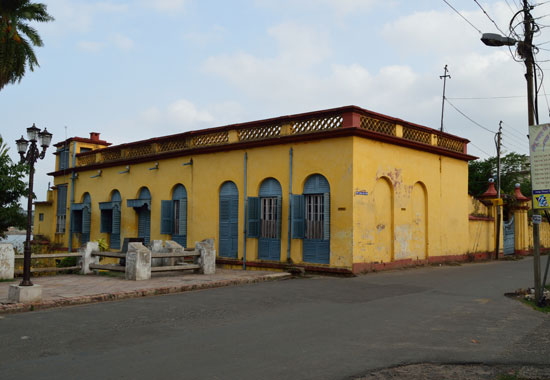
Nearby attractions:You can make a trip to the temple of Hanseshwari housing the deity of Goddess Kali, on the bank of the Ganges at Bansberia, located 25 km. from Chandannagar. The temple with a towering height of 90 feet and featuring 13 peaks was built with limestone brought from Chunar, near Allahabad. Each peak of the temple represents a blooming lotus bud. There is also a Ananta Basudeba temple and a Swanbhaba Kali temple built by Raja Nrisinhadeb Roy Mahasay in 1788 located nearby and Patal Bari or the underground house.
The clock of Bandel Imambara is another sightseeing interest for the tourists. This 100 years old antique clock made of solid brass features letters in Arabic and measures around 3 ton. The Bandel Imambara truly offers visual pleasure with its magnificent structure. The interior of the mosque is decked with several chandeliers, Iranian carpets and the teachings of Koran are inscribed on the wall. The Portugese Church in Bandel built in 1599 is also a must visit for tourists.
Best visit time: Though the climate of Chandannagar is similar to Kolkata, winter with pleasant climatic condition is the ideal time for visiting the place. Chandannagar is also famous for the five-day long Jagadhatri Puja which is held with tremendous fervor and pomp during November every year. You can visit Chandanagar during this time of the year too.
Dasghara (Hooghly- 70 km. from kolkata)

Dasghara is an ideal destination for the tourists having true interest in history because this small village near Tarakeshwar treasures some remarkable terracotta temples and architectures. This quaint village is situated 12 km north of Tarakeswar, famously known as the temple town.
Though most of the sites in Dasghara only house the ruins of the historical structures, still nothing could diminish the attraction of the place. The central attraction of the tourists visiting Dasghara is a temple built in the Mughal era, admired with decorative terracotta work. The oldest construction of the village is the Gopinath Temple, built by a local zamindar called Sadananda Biswas. The temple features five spires and some of its significant terracotta panels are still in good condition. The panel features some notable scenes from the Ramayana, a grand court, performances of the musicians and glimpses of regular life. It is said that this masterpiece is one of its kind in whole of West Bengal.

Nearby attractions:You can arrange a trip to the Tarakeswar temple, Terracotta Panels from Gopinath Temple, Dasghara, Clock Tower, Roy bari, Biswas Mansion, Dasghara.
Best visit time: You can visit Dasgara any time of the year.
Deulti (Howrah- 48 km. from kolkata)
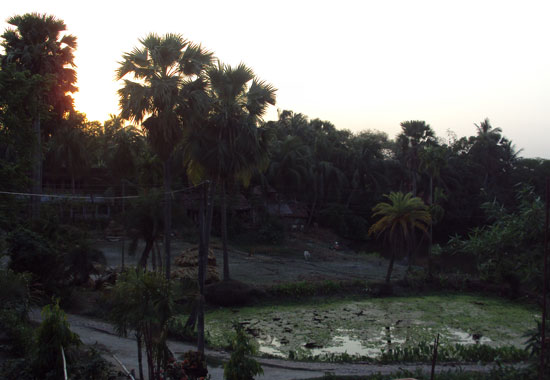
If you are looking for a rural escape, away from the bustling city life, then you can make a tour to this small village of Deulti, nestled amidst a serene ambience. This peaceful retreat is located about 6 kms towards the western part of Bagnan, in the district of Howrah in West Bengal. It is the second nearest village to Deulti station, after Mellock.It is a perfect holiday destination, cradled on the bank of River Roopnarayan.
Deulti is rich with its heritage and culture. The neighboring village of Deulti called Samtaber is popular among the tourists for being the abode of the famous author Late Sarat Chandra Chattopadhyay.
Samta is a village and a gram panchayat in the Howrah district of the Indian state of West Bengal. Samta's history dates back to centuries. During British Raj Samta was ruled by the Roys, who were the Zamindars of the village. The Roys were initially Banerjee, but were later given the title of Roy. The Zamindars were subordinate to the Bardhaman Raj Estate, who were in turn subordinate to the British Empire. A memorial in the remembrance of Ishan Chandra Roy, a member of the Roy family, existed in the village but now is underwater and only a part of it is visible, peeping from the pond's water surface. The Roys still live in Samta. Goddess Shitala is the family deity of the Roys and a temple dedicated to the goddess exists in on a hill in the village. A cluster of the Roy family still lives on that hill.
After India attained independence, Zamindari was abolished and the village was taken over by the Government of India.
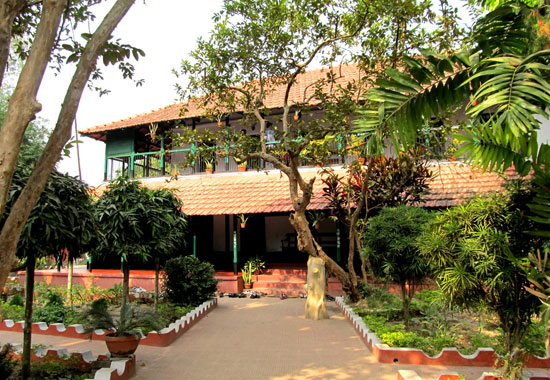
Nearby attractions:Kolaghat is just a few minutes drive from Deulti. Garchumuk and Gadiara is also nearby.
Best visit time: The summers are also quite harsh. Winters would be the best time to visit Deulti.
Dwarhatta (Hooghly- 41 km. from kolkata)
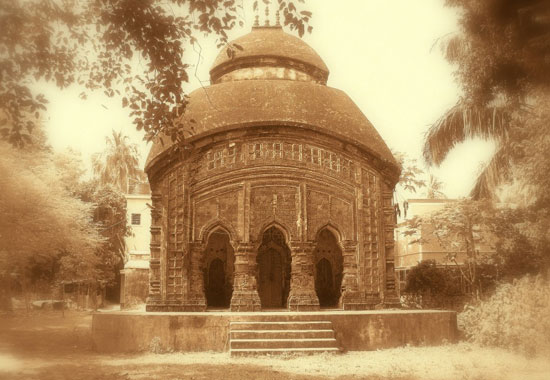
The terracotta temples guarded by lush green thickets makes Dwarhatta peaceful and serene. Located 41 km from Kolkata, Darhatta is one of the villages in Haripal, in the West Bengal's Hoogly district.
The major attractions of this place are its terracotta temples. The Vishnu and three Shiv temples constructed by Singha Rai family, the zamindars of this place, are the most popular sights. One of the three temples is Rajrajeswari-Shiva terracotta temple, constructed by Pannalal Singha Rai. The walls of this temple are adorned with scenes from Ramayana, Indian mythology, and Radha- Krishna.
Apart from sightseeing, you can watch huge varieties of birds in the village of Darhata. You can also watch the village market that opens weekly, is a spectacle in itself.
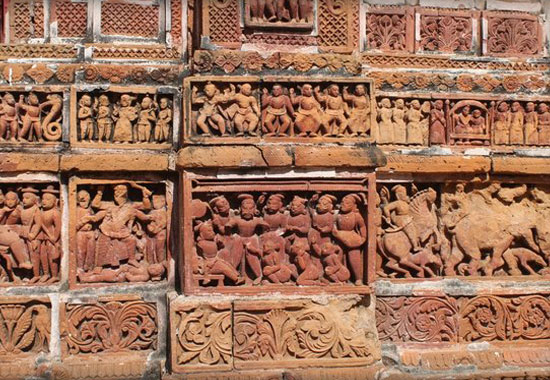
Nearby attractions:You can visit the nearby main city of Chinsurah just 35 km away.
Best visit time:you can visit Dwarhatta anytime in the year. In the summers, the green shade of the trees will protect you from the scorching rays of the sun.
Gadiara (Howrah- 96 km. from kolkata)
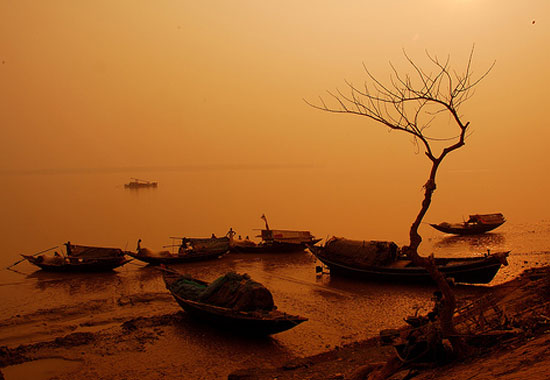
Gadiara is a village in Howrah District of West Bengal, India. This place is the point of convergence of the Damodar, the Rupnarayan and the Hoogli rivers. Gadiara is a popular picnic and daytrip spot for locals and tourists alike.
The rivers meet here to form a huge expanse of waterbody with towns like Haldia, Geonkhali and Nurpur on their banks. The twinkling lights of these towns viewed from here across the river in the evening is a great experience.
Savor the spectacular sunrise and sunset over the vast expanse of water. Take a walk along the riverside and spend some quality time taking a boat ride on the river. Idling along the river bank and taking lazy village walks are the best things to do here.
It is hardly 80–90 km from Calcutta and there are frequent bus services both private and state-owned (CSTC), from Esplanade, Kolkata. There is an old dilapidated fort, Fort Mornington, built by Lord Clive in Gadiara. The fort was heavily damaged during the devastating flood in 1942. There is a small lighthouse installed in Gadiara.
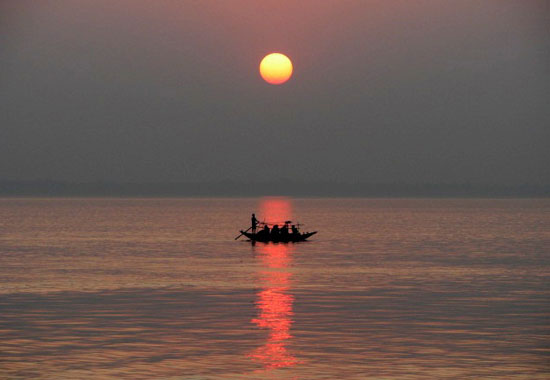
Nearby attractions: The major nearby attraction is Garchumuk. You can also visit nearby Geonkhali by crossing the river by regular ferry service.
Best visit time:You can visit Gadiara any time of the year. The evenings are usually cool with winds flowing over the river.
Garchumuk (Howrah- 60 km. from kolkata)
.jpg)
Garchumuk is located on the district of Howrah of West Bengal at the confluence of River Hooghly and River Damodar. The spot, offering the spectacular view of the Ganges is gradually emerging as a popular tourist destination ideal for a weekend tour. It is situated at the converging point of the two rivers, Damodar and Hooghly (which is Ganges), which enhances the scenic beauty of the location.
The prime attraction of Garchumuk is the beautiful barrage, popularly called 58 No. gate or Atanna Gate, where 58 lock gates have been built. Visitors flock at the site to view this extensive barrage. Garchumuk also features a nice deer park. You can also spot irrigational canals connecting the rivers Damodar and Hooghly. Above all, it is the breathtaking natural beauty of the river Ganges and its surroundings that fascinate the visitors.
Garchumuk is an ideal picnic spot for the tourists amidst the natural splendor. There are also provisions of boat riding on the river Hooghly at Garchumuk.

Nearby attractions: Gadiara is a major nearby tourist attraction, located at a distance of 22 km. from Gorchumuk. It is also a popular picnic spot.
Best visit time: Garchumuk is ideal to visit round the year.
Guptipara (Hooghly- 80 km. from kolkata)
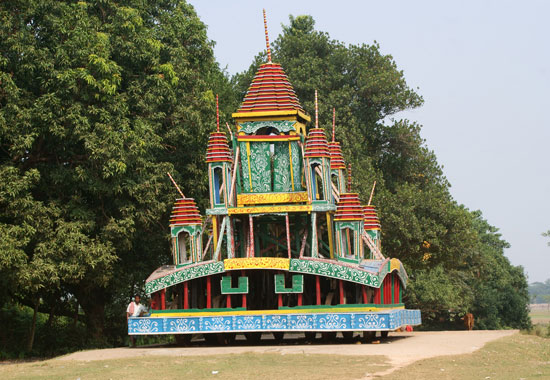
Guptipara is a rural town under Balagarh police station in Chinsurah subdivision of Hooghly district in West Bengal, India.
Guptipara is a rural town beside the Hooghly River, located between the three districts of Nadia, Hooghly and Burdwan. Due to its geographical significance, it is under the Hooghly-Burdwan Rice belt. And the paddy fields of Guptipara produces the finest rice in West Bengal. But the main attraction is the "Himsagar Aam" (The most tasty mango on Indian soil). Apart from Malda, mangoes of Guptipara have got some national fame.
Guptipara was one of the main places in ancient India where "Sanskrit Toles" and many Pandith lived hear "Pathmahal"one of them place and "Raghu Nath" mondir and Mela was oldest festival,were situated in large numbers, Still someone can find many of the oldest "Punthi"s in the preserved condition in "Sisir Bani Mandir Pathagar" the government library of Guptipara.
Guptipara has always been an interesting place for Bengali & Indian culture, There are several reasons for which The Guptiparans can celebrate. Ratha Yatra, Jagadhatri Puja, Durga Puja, Dol Yatra, Jhapan, Kali Puja & many local festivals including Guptipara Rathayatra.
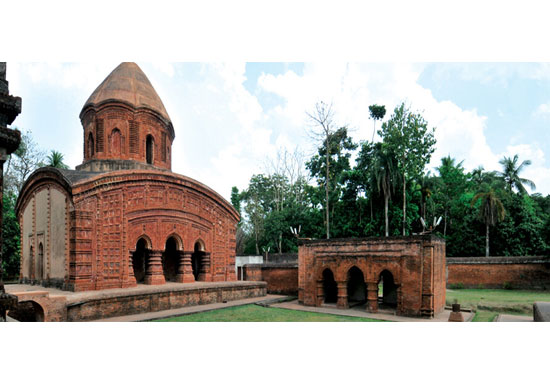
Nearby attractions: Among the nearby attractions from Guptipara, you can visit Bandel, famous for Bandel church as well as Kalna town and Bansberia.
Best visit time: You can visit Guptipara during anytime of the year.
Routpara (Hooghly- 82 km. from kolkata)
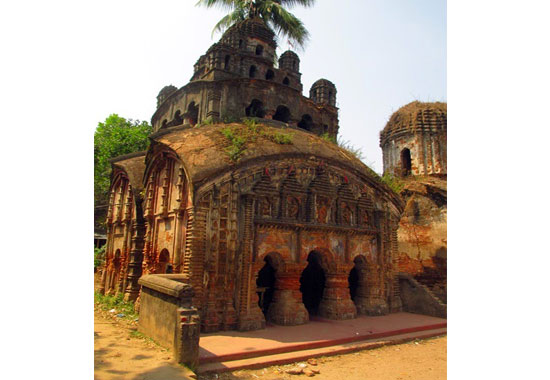
The quaint village of Routpara located in the Arambagh subdivision of Hooghly district is such a destination, which can offer you with some interesting experience.
Rotupara, better to term as a temple city of Bengal, upholds the blend of the two architectural style of temples in Bengal – Ratna (pinnacle) and Chala (sloping roof). The region is famous for housing five temples, three of which have already turned into ruins. You can visit the Mangal Chandi Temple admired with 13 pinnacles, though none of the pinnacles are in decent condition.The fourth temple is a small shrine of Lord Shiva, which was probably built afterwards.
You can visit the temples and the ruined temple sites of the location, which are of major historical importance for their architectural style. Explore the region to locate some other historic terracotta structures.
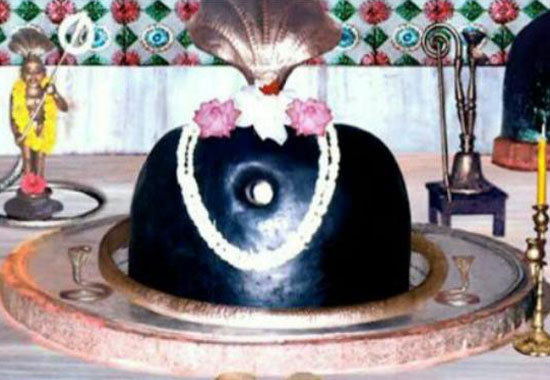
Nearby attractions: Tarakeshwar temple is a very popular attraction nearby.
Best visit time: You can visit the destination any time of the year.
Sukhadia (Hooghly- 80 km. from kolkata)
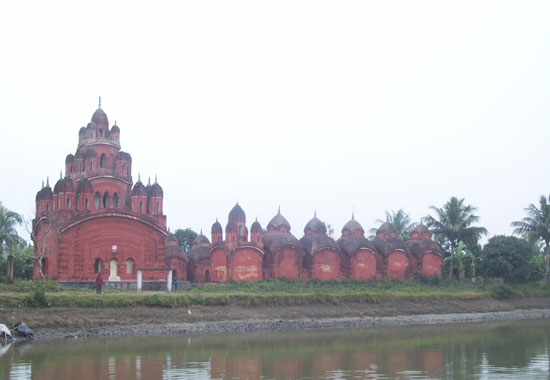
The quaint village of sukhadia will offer you a unique experience. Located at a distance of 80 km from Kolkata, sukhadia, situated in the Hooghly district can better be termed as the abode of terracotta temples attracting history lovers to three medieval shrines of the 18th century.
sukhadia is admired with three major gracefully designed temples, which are the prime spots of tourist interest. The most notable temple was built by the village zamindar Bireswar Mustafi, in the year 1813 in the eastern part of the village. The temple, famously known as the Ananda Bhairabi Temple, houses the deity of Anandamoyee Kali. The shrine admired with 25 pinnacles, is a masterpiece of temple architecture and there are only five such temples in West Bengal.
You can also visit the temple of Harasundari, built by another renowned zamindar, Kashigoti Mitra in the western zone of the village of sukhadia.
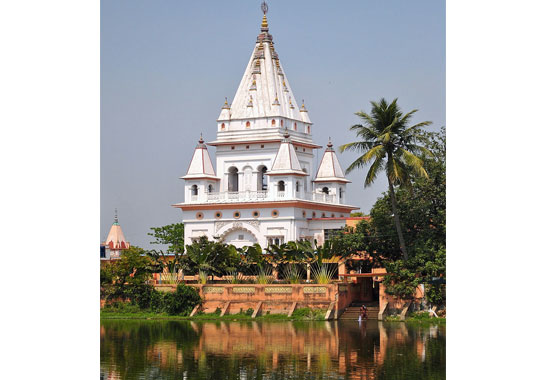
Nearby attractions: Nabadwip is nearby.
Best visit time: You can visit sukhadia any time of the year.
Bandel (Hooghly- 40 km. from kolkata)

Bandel founded by Portuguese settlers, is an urban area in Chinsurah-Mogra block in Chinsurah subdivision of Hooghly district in the Indian state of West Bengal. It is under Chinsurah police station and is a part of Kolkata Metropolitan Area . Bandel is a major rail junction station of Eastern Railway, it is 40 km from Howrah station.
At Bandel there are two railway stations, Hooghly railway station and Bandel Junction. Bandel Junction is an important railway station of Eastern Railway and is a model rail station. The station is situated approximately 40 km from Howrah station on the Howrah-Bardhaman Main Line. The Bandel-Katwa meets the Howrah main line, here at Bandel Jn. Another branch line connects Bandel with Sealdah and Kolkata station via Naihati Junction. An EMU car-shed as well as a goods yard is situated in the neighbourhood of Bandel station.
Earlier, there was a Portuguese settlement at Bandel. The Church and the Monastery were built around 1660 by the Portuguese. Bandel word derived from Portuguese word mast of ship. Bandel Church is one of the oldest Christian churches in West Bengal and a nice Tourism attraction. It is dedicated to Nossa Senhora do Rosário, also known as "Nossa Senhora da Boa Viagem", meaning "Our Lady of the Good Journey". The keystone of an older church with the year 1599 on it adorns the riverside gate of the monastery attached to it.
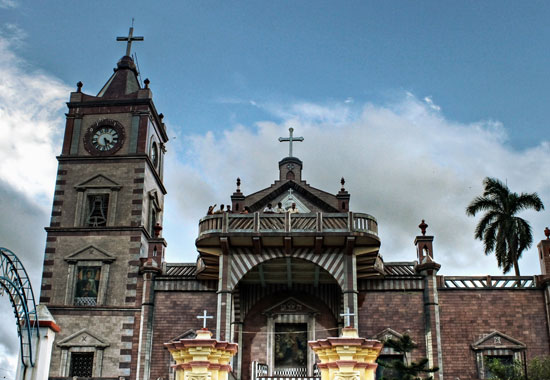
Nearby attractions: Bandel Imambara, Bandel church.
Best visit time: You can visit bandel any time of the year.
Chinsurah Imambara (Hooghly)
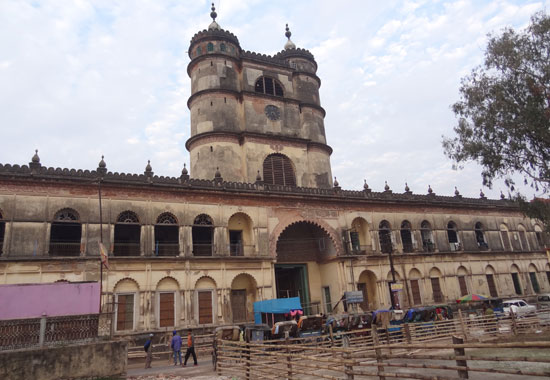
Hooghly Imambara is a mosque cum imambarah administered by shiah astna-ashari sect of Muslims, in Hooghly, West Bengal. The construction of the building was started by Muhammad Mohsin in 1841, which completed in 1861. The building is a two storied structure, which a tall clock tower over the entrance gate. The mosque within the complex has intricate designs and texts from Quran engraved on the wall. The interior of the mosque is decorated with marbles, candles and hanging lanterns.
Bandel Church (Hooghly)

The Basilica of the Holy Rosary commonly known as Bandel Church is one of the oldest Christian churches in West Bengal, India. Situated in Bandel, Hooghly district of West Bengal, it stands as a memorial to the Portuguese settlement in Bengal. Founded in 1599, it is dedicated to Nossa Senhora do Rosário, Our Lady of the Rosary. It is also a parish church, part of the Roman Catholic Archdiocese of Calcutta.
A ship's mast stands in front of the church; it was presented to the church by the captain of a vessel that had encountered a storm in the Bay of Bengal, and its rescue was attributed to Mary. The church has three altars, several tombstones, an organ, and a shrine to Mary.
Chinsurah Clock Tower (Hooghly)

Chinsurah Tower Clock, which is situated at the heart of the town, is the sole witness of the millions of incidents took place in past 101 years. A steel made hollow clock tower consisting 4 clocks in 4 different faces were shipped to Chinsurah by the British in 1914 to memorialize Albert Edward alias King Edward VII, eldest son of Queen Victoria and Albert of Saxe-Coburg-Gotha. That's why it is also known as Edwardian Clock. Four lamp sheds in 4 corners of this tower increase the beauty of this piece. Born on November 9, 1841 at Buckingham Palace, King Edward was crowned on 9 August, 1901. He was the King of the United Kingdom till his death (6 May, 1910) due to pneumonia. Edward visited India in 1875 before his appointment as a King. History witnesses that he was in favour of giving the proper respect to all the human beings irrespective of his class or religion. Some of the major decisions which were taken during his tenure were; Australia was granted the dominion status, motor buses were first used in London, juvenile court was introduced for the children, the Triple Entente was signed among Russia, France and Britain etc. In the year 1973, a statue of famous freedom fighter Bhupati Majumder (son of the soil who was closely associated with Bagha Jatin) was set up within the premises of this tower clock and it was inaugurated by the then Chief Minister of West Bengal Sri Siddhartha Shankar Ray.
Tomb of Susanna Anna Maria (Hooghly)
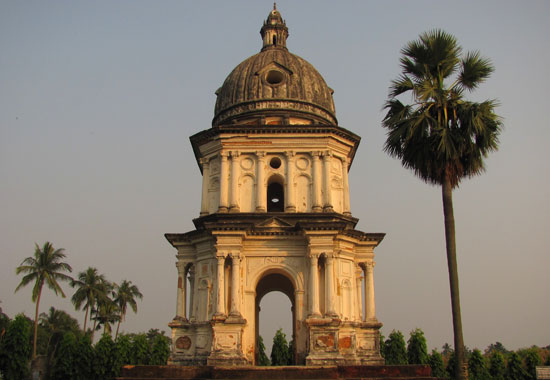
Located on the Grand Trunk Road, just outside the town of Chuchura (Chinsura) is the beautiful tomb of Susanna Annamaria. Susanna Annamaria was a Dutch Lady married to an Englishman named Mr Yeats. Although nothing much is known neither about the lady or her husband. Built in 1809 the Octagonal structure is an ideal example of Indo - Dutch architecture. The two storied octagonal structure, with arched gateways and slender columns is crowned with a dome. The grave contains no epitaph but the name Susanna Annamaria is inscribed in the drum of the dome.
Khanyan Rajbari (Hooghly)
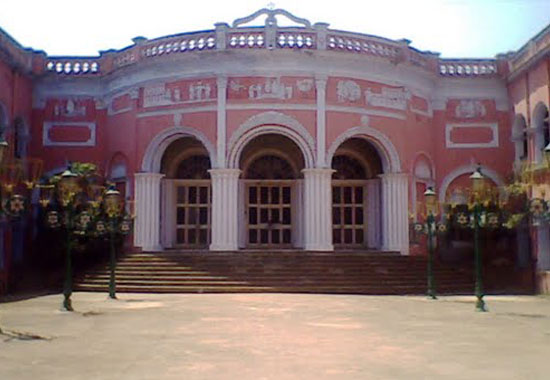
The other name for Itachuna Rajbari is ' Bargee Danga'. The term has been derived from Bargee , which was a name given by the bengali's to the Maratha warriors. There was a time when Maratha's attacked Bengal repeatedly to collect Chauth, which was 1/4th of the tax that was to be paid by the Nawab of Bengal( Sub-e-dar), Bihar and Orissa. Apocryphally, after Aurangzeb the downfall of Mughal empire had started. The Bargee's attacked under the the guidance of Bhaskar Pandit and Raghuji Bhosle from 1742-1752. Katwa , near Hooghly was made the early centre which was later changed to Medinipur. Though the Maratha warriors stopped their attacks after the assassination of Mir Habib, they gained control over Orrisa. As a result many maratha Bargee's stayed back in Bengal and started their own trade. They amassed a lot of wealth. One of such Maratha warriors were the Kundans, now known as Kundu's also settled here. The Itachuna Rajbari was built by the ancestors of Shri Safallya Narayan Kundu in 1766. The Govt.of India's policy of abolishing the Raj-culture hindered further flourishes of the Rajbari. It is the present inheritors of the family Shri. Rabindra Narayan, Shri. Dhruva Narayan and Shri. Basav Narayan Kundu along with Mylestones & Journeys who have decided to restore the glory and are making all efforts to maintain the royal heritage through regular upkeep. The Heritage Homestay is one such initiative through which village tourism may be promoted in this area.
